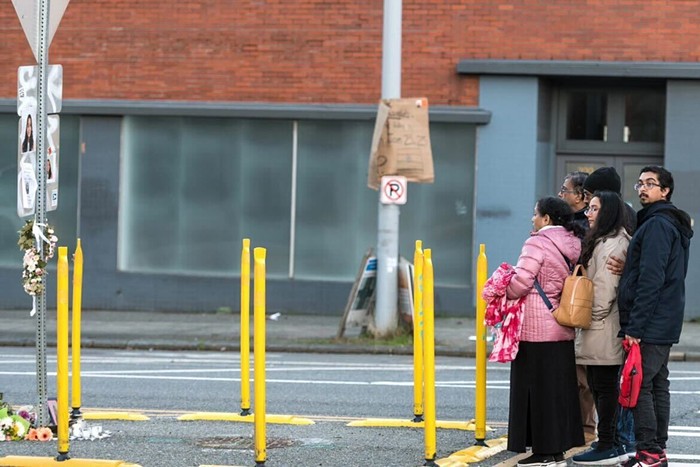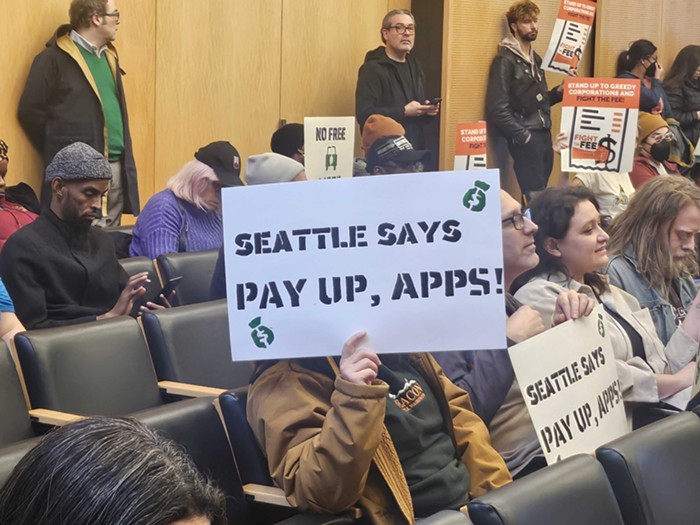"Public use of illicit drugs, blatant drug dealing, misuse of public facilities--people are dying of drug overdoses in our neighborhood," says Ann Donovan, Capitol Hill Community Council president. "People steal and beg to get money to buy drugs."
Many of the problems center on Cal Anderson Park, bordered by East Pine Street and East Denny Way, a block east of Broadway. People are shooting up heroin on the sidewalk, and in the park's new bathrooms. "The new restroom? It immediately got taken over," Donovan says. "I had a meeting at the shelter house [next to the bathroom], and we were sitting there with eight people in the room, and there were people shooting up right outside. And they could see that we could see them." There's prostitution in the same bathrooms. On benches along Pine Street, groups sit and drink during the day, often arguing loudly or shouting at passersby. Still more people camp out in the park day and night, curling up in the bushes or just dozing in the grass.
There's nothing inherently wrong with drug use, prostitution, or drinking (hell, this paper is all for all three). Cities are places where adults should indulge their vices. The problem comes when those vices start to become concrete problems for others. It's no longer a victimless crime when other people in the neighborhood are forced to deal with your drug use, dealing, and sex work every day. Kids can step on the needles, property values decline, residents' sense of security drops, and the entire homeless population gets blamed for the problem.
Neighbor Brad Trenary, who lived across the street from the park for 10 years, is certainly sick of it. He's been doing daily patrols of the park all summer and documenting what he sees. He sends his unsolicited reports to the city. In his June 25 report, he wrote: "On a daily basis, there are at least two to three groups of street persons, anywhere from teenagers to well-seasoned adult homeless persons, who are congregating on [the] ball field. These are not small groups. They range in size from 10 to 20 people. They are hostile, aggressive, foul-mouthed and filthy dirty. They leave enormous amounts of trash and debris behind, not the least of which are hypodermic needles, empty vials of saline solution (which amazes me), beer and wine bottles, tampons, [and] toilet paper. Frequently, there is clothing of all types spread all about the park. In the bathrooms, I have found bloody socks and underwear that are too nasty to imagine." Gross.
Donovan says the park's problems coalesced this summer, because of several factors. "Construction pushed things out of the [reservoir area of the] park. There was an extended stretch of nice weather." Also, social services have been cut around the city, including drug-treatment beds. And the newly enacted Alcohol Impact Area in Pioneer Square seems to be pushing public inebriates up to Capitol Hill, where they can still buy a single can of cheap beer.
The park isn't the only problem area--or "hotspot," as the police department calls it--around Capitol Hill. Neighbors report plenty of drug dealing in front of the post office at Broadway and East Denny Way. Dealers hang out there, making calls on the pay phones and stashing drugs in newspaper boxes. "They hide it under a few papers," reports resident Gary Clark.
Along Pike and Pine Streets, among all of the boutique stores and popular bars, public drinking is the biggest problem. Seattle Central Community College fenced off a vacant property on Boylston Avenue this summer, apparently to curb drinking in the lot, though empty bottles still litter the space. Groups of homeless men wander the corridor asking for spare change. And on the eastern edge of Capitol Hill, near East Madison Street and 22nd Avenue East in the Miller Park neighborhood, residents have been complaining for years of drug use and prostitution in their own yards, plus drug dealing, frequent fights, and shootings on Madison in front of bars like Deano's and Oscar's II.
This summer, neighbors like Trenary and Donovan started working together to compare notes and come up with some solutions. "I realized that with all these different problem areas in one precinct, something should be done," says Andrew Taylor, head of the Miller Park Neighborhood Association. "We really should request more police."
Neighbors also talked about social services. Donovan's community council is trying to do an inventory of social services on Capitol Hill, to see what's there, and what might be needed. "We sort of know that Stonewall [Recovery Services] closed, but let's be more specific," Donovan says. "What would be more acceptable to the neighborhood? Could we site things like a hygiene center on Capitol Hill?"
On August 21, the community council sent a 24-page letter to the Seattle City Council and Mayor Greg Nickels--a compilation of residents' observations of criminal activity, and a plea for help. "Mayor Nickels, your election campaign platform included promises of increased public safety," the letter read. "That has not only failed to materialize, we see the standard that was being maintained has perceptibly decreased." The letter noted Nickels' cuts to the police department in the 2003 budget, and the general understaffing of the police department (Seattle is 27 percent below the average national cop-to-citizen ratio). "Additionally, citizen letters and emails complaining [about] public safety... are often met with no response from your office."
Indeed, Nickels has yet to respond to the letter. The mayor has a history of ignoring Capitol Hill. In his State of the City speech in January, the mayor tagged several neighborhoods in need of assistance, but failed to mention Capitol Hill, though the area was already clearly in crisis and the mayor's staff had promised that Capitol Hill was "on the agenda." And in his budget address last month, Nickels mentioned Broadway as a priority neighborhood, but didn't list any specifics, as he did for other tagged neighborhoods like South Lake Union and Northgate. Nickels did offer a solution to Cal Anderson Park's problems on October 14, but it seemed more PR strategy than substance.
- - -
Capitol Hill residents have gotten a response from several city council members. Jim Compton made a bid at solving the neighborhood's woes a few weeks ago, but it's mostly a stopgap measure. In a letter to residents on September 24, Compton said, "[I]t is abundantly clear to me that the level of staffing in the East Precinct is simply not enough to handle the problems you are encountering. I have called upon Chief [of Police Gil] Kerlikowske and the precinct commanders to loan officers to the East Precinct to better address the criminal behavior you have witnessed." Compton sent a memo to Kerlikowske and the heads of all five police precincts the same day, requesting the cop reshuffle and asking for suggestions on how to flat-out increase the number of Seattle cops through the upcoming budget process. It was a new strategy for cop committee chair Compton, who rarely--if ever--gets involved in the day-to-day management of police resources at the precinct level. His aides report that their phone "blew up" the next morning with calls from precinct captains upset over Compton's meddling.
Some residents were skeptical of the letter, noting that Compton is up for reelection and hadn't been particularly responsive to neighborhood concerns before, despite a tour of the Madison and 22nd area hotspot nearly two years ago. "It wasn't ever clear what he did as a result of walking around with us," Taylor says. "It was hard to see what the initial result was."
Neighbors have gotten the best response from council member Nick Licata (members Richard Conlin and Judy Nicastro also wrote residents to offer support). Licata met with residents at a home near Cal Anderson Park several weeks ago, after doing a loop around the park. "I toured the park. It was amazing. Within the first hundred yards I saw human feces, and I saw a very young woman incapacitated on drugs," Licata says. "I met with Brad [Trenary] and the organizers there a week ago, and I promised them that I would not drop this issue until we found a solution."
In just two weeks, he had kept his promise. Licata immediately got to work crafting a "neighborhood safety initiative," which would funnel nearly a million dollars into social services, police, and environmental design (things like better lighting) in both the East Precinct and the West Precinct (where Belltown and Pioneer Square are also plagued by similar issues). He's currently looking for funding sources via the current budget process. One possible source is $700,000 the mayor directed toward capital improvements in the East Precinct--curb bulbs on Pike and Pine, crosswalks on 12th Avenue, and other pedestrian improvements on Madison. Though neighbors would love to see pedestrian improvements, many want cops first.
"It doesn't do any good to have a nice crosswalk if people are afraid to go out of the house to use the crosswalk," Licata observes. "The mayor's plan isn't necessarily a bad plan, but it's putting the cart before the horse."
Licata says the money--which is funded through a real-estate excise tax and has to go toward capital improvements, not public safety or social services--could be swapped into the city's neighborhood matching fund for its projects, which are capital-improvement heavy, and other cash could be moved from the neighborhood matching fund budget to address safety issues on Capitol Hill.
Licata's top priorities? "We definitely need more bike cops. And bike cops specifically--their range is longer than foot patrol, and they're more personal than car patrol. Let's have dedicated bike patrols. Six new bike cops for the East Precinct, and I'm going to try to do the same for the West. And you've got to have a social service element. Police presence by itself doesn't work. Social services to people who are out there, to get them off the street permanently." The neighbors couldn't agree more: "We're not trying to kick people out of the park," Trenary says. "We just want them to use it legitimately." Donovan says she'd like to see help offered to addicts first, "but when people are reluctant to go to treatment, that's where law enforcement steps in."
"More cops!" was the drumbeat when Capitol Hill neighbors went to the city's packed public budget hearing on October 8. (A competing drumbeat, however, came from South Lake Union Vulcan lackeys stumping for Nickels' pet neighborhood project, the South Lake Union streetcar, which is already slated to get $6 million in the proposed budget.) As for social services, Donovan says the neighborhood wants, at the very least, $30,000 in continued funding for Capitol Hill's case manager--a title held by Randy Nelson of Street Outreach Services, who works with street youth to help them get the services they need, and acts as a liaison between social services providers and the neighborhood. "It's a very small amount of money for a very needed position," Donovan says.
Indeed, social services are key on Capitol Hill, a neighborhood that has long embraced homeless adults and street kids as residents of the area. "Capitol Hill residents are sophisticated. They're politically and socially aware," Licata says. "They're not saying, 'Just arrest the homeless people.'" And most folks want to help the homeless people, though not necessarily by tossing quarters at them on the sidewalk. But in the last year, the neighborhood has lost its youth drop-in center, a curbside food service, and a drug treatment center--victims of either a poor economy and lack of funding, or issues with their landlords.
Nelson sees plenty of opportunity for more services in the area. "I think one thing we definitely need is easier access to drug treatment," Nelson says. "Something that might be good is a person who works specifically with chemical dependency issues on Capitol Hill."
Licata has also mentioned an even bolder idea--a safe injection site, akin to the one in Vancouver, BC. It would be a place where addicts could go to get clean needles and administer their drugs under the watchful eye of medical personnel. "I'm beginning to think maybe that's something we've got to look at. If they've got a solution in Vancouver that works, if that takes drug use out of the parks, then I'm okay with it," Licata explains. "If you have a safe injection site, you're not going to have kids stepping on broken needles in the sandbox. Seattle has a reputation of being the heroin capital of the West Coast. And we're just ignoring it." In 2002, there were 87 heroin-related deaths in King County--a huge jump from 2001 numbers.
- - -
The neighborhood is already seeing some changes, thanks to a team effort from a few city departments--including the parks department, the cops, and the Department of Neighborhoods. Representatives from those departments have been meeting for weeks to address problems in and around Cal Anderson Park.
"We're having each department step up to the plate and do what it's supposed to do," says parks rep Royal Alley-Barnes, who manages parks in the Central-East section of Seattle. "We're doing what we can already do, and doing it fast." For her, that meant hiring a part-time park aide--a young homeless woman who reminds park users of the rules, trims hedges, and cleans up litter--and quickly completing work orders for things like vandalism. Parks employees also have been locking one door on each of their bathrooms, leaving the other door as both the entrance and exit, to prevent folks who are doing illegal activities from sneaking out the back. "We've had a 50 percent reduction in biohazards and illegal activity by locking one door," Alley-Barnes says. And on November 5 at 7 p.m. the department will host a community workshop about the park, at Miller Community Center on 19th Ave. E.
For its part, under the direction of Captain Fred Hill, the East Precinct--which sits just one block away from the park--put together a team of officers to step up patrols of the neighborhood by October 22. (It appears they've started early--while walking around the park one recent week, I was nearly mowed over by a pair of bike cops three times. Another resident reports a police sweep of the corner by the Broadway and Denny post office last week.)
Those city efforts--and, residents wryly note, the recent rain--have all but emptied the park. But residents report that the former park denizens have simply set up shop in doorways around the neighborhood, and even in the nearby QFC. One Pine Street resident reports seeing a few homeless men sleeping behind QFC's floral counter last week, until store employees found them and kicked them out. And the crowd at the post office persists.
- - -
Enter the mayor. On October 14, the mayor issued a splashy, no-nonsense press release, announcing a "17-step action plan to keep Cal Anderson Park safe." The half-baked plan--which took effect "immediately"--was quickly put onto the mayor's website, and garnered some daily headlines.
Here's the plan. First off, East Precinct Captain Hill will personally attend community meetings. Cops will also enforce the parking restrictions around Cal Anderson (three-hour parking regulations were added last year to discourage camping), and "aggressively" issue citations under the parks exclusion ordinance--a problematic and controversial Sidran-era program that allows officers to ban folks from a public park without due process--to people violating rules or laws. Cops will sweep the park at closing time--11:30 p.m. --to cite people who are there after hours. Cops will enforce narcotics laws. Parks employees will keep the park clean. Vandalism will be repaired. Seattle Central Community College--which hosted a meeting last month to address the area's problems--will be more involved. And benches and bleachers will be removed, to discourage camping and loitering.
So was the mayor finally getting serious about Capitol Hill? Hardly.
First of all, Captain Hill already attends meetings. And while the cops may not always tow cars at the 72-hour mark, they certainly enforce the three-hour parking rules (you can count my tickets if you'd like). As for the parks exclusion law, Donovan notes 100 parks citations have been issued so far this year. And we don't need to amp up a civil-rights-stomping Sidran law that seems to grant redundant enforcement powers to the police. The problem is that there aren't enough cops to keep up with 911 calls, let alone regular park patrols. What few cops Capitol Hill has already enforce the laws--that's their job.
The parks department, as noted above, is doing its best to fix up broken park elements as they occur. SCCC's already involved, thanks to their new president, Dr. Mildred Ollée. And the benches-and-bleachers thing is just weird--isn't it supposed to be a park, where people can sit down or watch their kid's soccer game? Heck, cops on Broadway often steer homeless folks off the sidewalks and into the park--where they're allowed to sit. "I think there is a fine line between making the park inhospitable to illegal activity and making the park inhospitable," case manager Nelson says.
So thanks for nothing, Team Nickels.
Really, most of Nickels' "new" plan was already happening, courtesy of the focused interdepartmental team and neighborhood pressure. The mayor simply stepped in to take credit for it. And his plan made no mention of the two things neighbors want most: more cops and more social services funding, the things Licata is addressing. Frankly, Nickels' plan is too rudimentary to turn things around on Capitol Hill--when the illicit activity dies down over the wet winter, parks employees and cops will return to their regular duties. By next spring, the problems at the park will probably return.
Before the mayor's "solution" was announced, neighbors were grumbling about Nickels' lack of response to their pleas for help. He still hasn't replied to the community council's August 21 letter (and his plan does nothing for Capitol Hill's other hotspots, like the Madison and 22nd area). While residents are happy that the mayor is paying a bit of attention to their concerns (hard not to, when several papers have done stories on Trenary's daily park patrols), they're still looking to Licata--who already has the support of Richard Conlin, Peter Steinbrueck, and Judy Nicastro--for real solutions. "I think we hit the bottom of what we're willing to take," Donovan says.


















